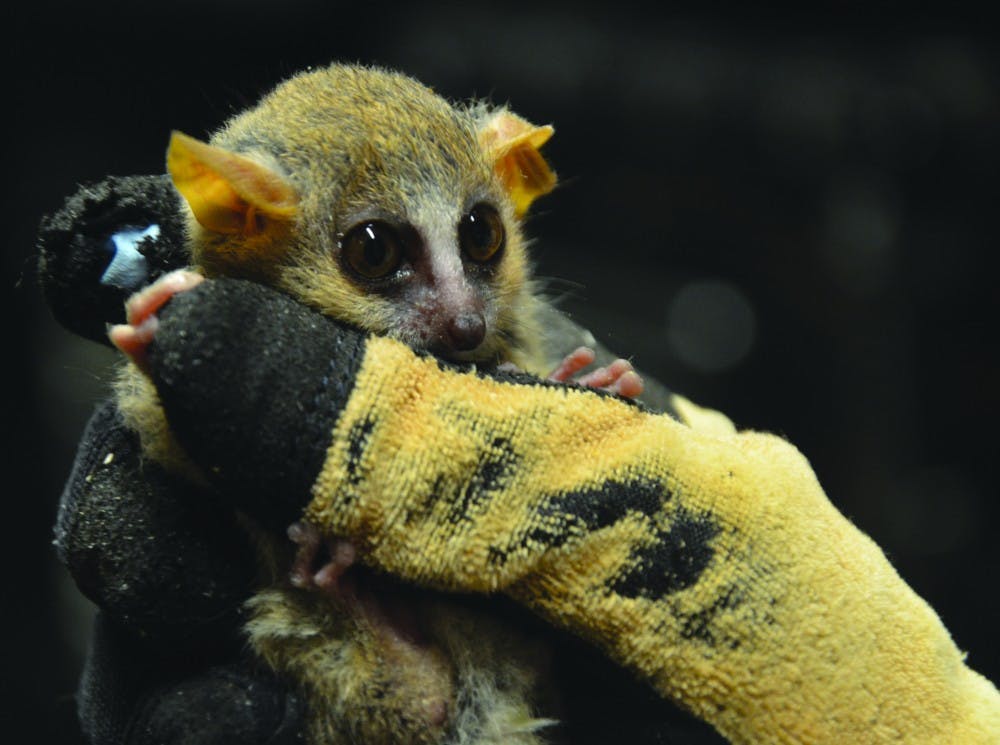This summer, Duke welcomed two new members to its community—each weighing no more than a handful of paperclips and standing less than three and a half centimeters tall.
Filbert and his sister Scuppernong, twin grey mouse lemurs, were born on June 18 at the Duke Lemur Center. DLC Director Anne Yoder said the birth of these twins is particularly significant in terms of the Center’s research, because mouse lemurs have been documented to show symptoms of dementia very similar to the onset of Alzheimer's in humans. By studying mouse lemur genomes, the Center hopes to shed light on the nature of Alzheimer's.
“We’re really finally able to do some really penetrating kinds of diagnostic analyses and genotype-phenotype correlations for the first time, and it’s the mouse lemurs that are enabling us to do that,” Yoder said. “Every individual that is born not only provides another data point for these types of studies, but is also a potential parent for the next generation.”
Over the past two years, Yoder has been working in conjunction with the Baylor College of Medicine's Human Genome Center to sequence, assemble and annotate the genome of the mouse lemur using next-generation sequencing technology.
Annotating the genome will aid scientists who are trying to identify the particular part of the genome that is causing the symptoms of Alzheimer's, Yoder said. Although this final step has yet to begin, the entire process of data collection and analysis will likely be done by next spring or summer, she added.
It is uncertain, however, whether Filbert or Scuppernong will be used for research in the near future. Yoder said that the DLC has funding to use noninvasive neurological scans to observe the brain development of one young male and female lemur, although the Center has yet to determine which individuals will be used.
Bevan Clark, lead primate technician, said that the staff used to name mouse lemurs after herbs and spices, but they eventually ran out of names. She chose the name Filbert because "he looked kind of like a Filbert," and Scuppernong because it is "a good, Southern mouse lemur name."
Filbert and Scuppernong are also important to the Center because their father, five-year-old Asparagus, had yet to successfully breed, Clark said. Because the babies are Asparagus's first offspring, they enhance the genetic diversity of the population.
"We’d been trying for years to get Asparagus to breed, and he just couldn’t because the other males were more aggressive than him and because there were bigger females around,” Clark said.
Maintaining genetic diversity is a large challenge that captive breeding programs face, Yoder said. With a lack of genetic diversity comes a slew of negative effects including increased disease susceptibility, morphological anomalies and behavioral anomalies.
Similarly, at a sprightly eight months old, the twins’ mother Juneberry is a first-time parent as well, which increases the twins' genetic diversity compared to the rest of the captive population.
“We’re always very vigilant about trying to outbreed as much as possible to keep the population healthy,” she said. “The excitement of having novel genetic diversity introduced into the colony is just always cause for celebration.”
Clark said that while Scuppernong takes after her more laid back father, Filbert is more like his energetic mother Juneberry.
“[Filbert] is a typical mouse lemur—very angry when we have to grab him to weigh him, his tail twitches and he talks a lot. But his sister is much more mellow,” Clark said.
Scuppernong and Filbert are at a healthy weight of about 50 grams, and they are expected to be 60 to 90 grams when they are fully grown, Clark noted.
In order to accommodate their fast metabolisms, Clark said that the twins’ daily diet consists of two tablespoons of mixed fruits and vegetables, two tablespoons of powdered monkey food and 12 mealworms.
Get The Chronicle straight to your inbox
Signup for our weekly newsletter. Cancel at any time.

